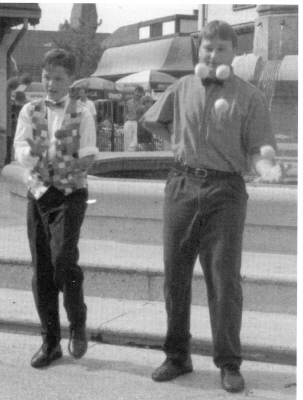
(l-r) Casey Boehmer and Dale Jones practicing one of Jones' bounce multiplex moves. |
Page 31 Spring 1995
|
But
Kennison began coaching Casey, and began booking the family act, which
grew to encompass everyone. Juggling has become the focus of family
life, with a 10-foot-ceilinged dining room converted to a juggling
room. The family also has keys to two gyms with the higher ceilings
Casey needs for his numbers tricks. With Kennison's direction and
their own determination, the family plans to present 200 of their
55-minute shows this year. Casey is involved in a five-person club
passing routine, and has a seven-minute solo toward the end of the
act.
"Richard
has new tricks for me to try every time I go to his house," said
Casey, who practices daily and often spends the entire weekend with
his coach.
Kennison
helped Boehmer put together a routine for the IJA Burlington festival.
He performed it almost flawlessly in preliminaries, then suffered the
dropsies when nerves caught up with him in the for-real performance.
But the crowd had never seen one-armed technical work and cheered him
heartily throughout the routine. It was good enough for third place,
and whetted his appetite for more pressure-packed experiences.
Though
Boehmer doesn't follow Jones's style, he has picked up some of his
multiplex moves. After Boehmer learned the three-inone-hand
multiplex, Jones showed him how to do four using a knee bounce. It's a
difficult move, but Boehmer learned it well enough to add it to his
routine at the Groundhog Day Festival this spring.
Jones
also shared his "Flower Pots of Doom" routine with Boehmer,
enticing the youngster to buy some shaker cups and practice with that
prop.
In
the mid- to late-1970s Jones invented some bounce-multiplex patterns,
because it allowed him to add more variety to his onehanded act.
"Juggling with just one hand and more than two objects is very
fast-paced, so I began looking for a way to make it slower and
easier," he explained.
His
three ball bounce multiplex begins with three balls in one hand, and a
toss of one ball to the "bounce point." (It can be a knee,
Boehmer
had figured this pattern out for himself, but Jones took him a step
further by teaching him a four ball in one hand "diamond"
multiplex pattern.
It
begins with one ball sitting atop three others in the palm. You should
be able to hold onto the stacked ball with the tips of the thumb and
ring finger. Turn the hand sideways so the thumb nail faces you. Throw
the single stacked ball toward the bounce point and bounce it back
toward your hand. As it reaches its peak, toss all three remaining
balls together beneath it so that they form the corners of an upside
down triangle in the air.
Catch
the bounced ball as it falls toward your hand, and catch the lower of
the two balls coming down to your hand from the multiplexed throw. At
the same time the final ball comes down to your hand from the
multiplex throw, the third multiplexed ball hits the bounce point and
rebounds back up in the air toward the hand. Continue the pattern as
before.
Jones
has also invented a one handed five ball multiplex pattern by
increasing the bounces involved. Holding five in one hand, toss one to
a bounce point and bounce it back toward the hand. As it peaks, throw
all four of the others into the air. Two will again come back down to
the same hand that threw them. But the other two must be thrown to two
bounce points, the upper leg and the knee. One lands on the upper leg
slightly before the other. hits the knee, and the upper leg ball is
bounced directly back to the hand. As the knee bounce hits, however,
bounce it out and down to give yourself more time, then hit it a
second time with the foot back toward the hand for the final catch.
The ball you kick begins the second revolution.
He
said of it, "This is the most difficult one handed pattern I have
ever developed, but I consider it both easier and more practical than
He
continued, "You'll have to practice aiming the two balls that are
bounced one after the other so that they come down correctly over your
upper leg and knee. Honestly, the whole pattern takes work. But your
efforts will be worth it. It will blow your audience away, its a real
wow!"
"Learning
to bounce two balls off my leg instead of one has allowed me to not
only juggle more numbers, but also complete more difficult tricks. For
instance, I can now throw four balls simultaneously behind my back and
come out juggling. Two years ago I would have thought something like
that to be impossible."
But
wait, there's more! By tossing two balls straight up at first instead
of one, and then repeating the four ball diamond bounce multiplex
as above, Jones has been able to do six in one hand.
But
he has not worked only on one-handed patterns. Jones has worked over
the past decade with his atrophied right hand, and can now catch and
slightly throw balls with it. He has developed a six ball two handed
bounce multiplex that he has named 'Jones's Gem."
He
sees almost limitless possibilities for these bounce multiplex
patterns. "What excites me about the six in one hand pattern is
that a twohanded juggler could flash 12 this way!" |

(l-r) Casey Boehmer and Dale Jones practicing one of Jones' bounce multiplex moves. |